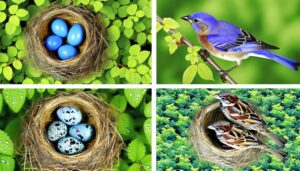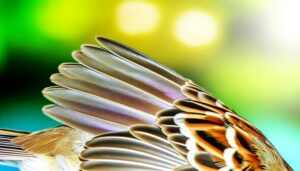How Much Food Do Sparrows Eat in Winter?
In winter, sparrows significantly amplify their food intake, consuming up to 30% of their body weight daily to meet the demands of thermoregulation. Preference is given to high-energy foods such as sunflower seeds, millet, and cracked corn.
Elevated basal metabolic rates facilitate heat generation, and sparrows accumulate fat reserves as an energy buffer. Snow cover influences foraging strategies, emphasizing the need for energy-dense foods.
Supplemental feeders can enhance survival rates by providing consistent, high-calorie food sources. Optimal feeding practices are pivotal for the survival of these birds in winter.
Learn more about their adaptive strategies and dietary needs.

Key Takeaways
- Sparrows increase their seed intake by about 30% during winter.
- They may consume up to 30% of their body weight in food daily.
- Sparrows prefer high-energy foods such as sunflower seeds, millet, and cracked corn.
- Increased caloric intake and fat accumulation are crucial for winter survival.
- Consistent supplemental feeders can enhance sparrows' winter survival rates by up to 20%.
Winter Feeding Habits
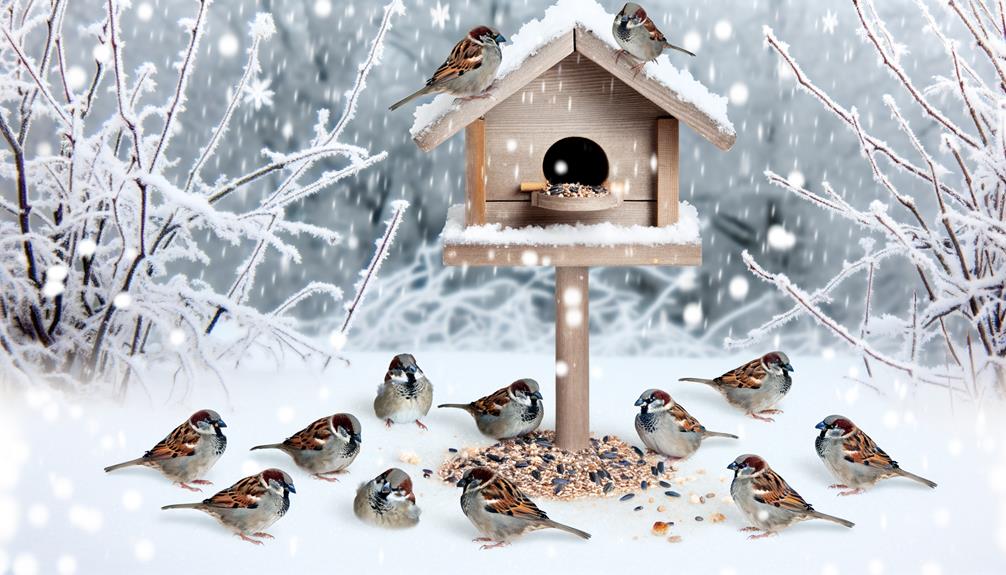
During the winter months, sparrows exhibit distinct feeding habits characterized by increased reliance on high-energy foods such as seeds and grains to meet their heightened metabolic demands.
Observational studies indicate a noticeable shift towards foraging in areas rich in these resources. Quantitative analysis reveals that sparrows increase their seed intake by approximately 30% compared to other seasons.
This behavior is driven by the necessity to maintain body temperature and energy levels under cold conditions. Researchers have documented a preference for sunflower seeds, millet, and cracked corn, which provide optimal caloric content.
Moreover, sparrows engage in caching behavior, storing surplus food in hidden locations to guarantee a steady food supply during periods of scarcity, highlighting their adaptive strategies for winter survival.
Energy Requirements
Sparrows' energy needs in winter are significantly increased, requiring a careful balance of caloric intake to sustain their thermoregulation and overall metabolic functions. During colder months, sparrows raise their basal metabolic rate (BMR) to generate enough body heat, a process that requires substantial energy reserves. The following physiological adaptations are crucial:
- Increased BMR: Enhanced metabolic processes to produce heat.
- Expanded Fat Stores: Accumulation of adipose tissue as an energy buffer.
- Thermogenic Activity: Improved muscle activity for shivering thermogenesis.
Research studies suggest that sparrows may consume up to 30% of their body weight in food daily during winter. Such heightened energy demands emphasize the importance of adequate and consistent food availability to prevent energy deficits and guarantee survival.
Typical Daily Intake
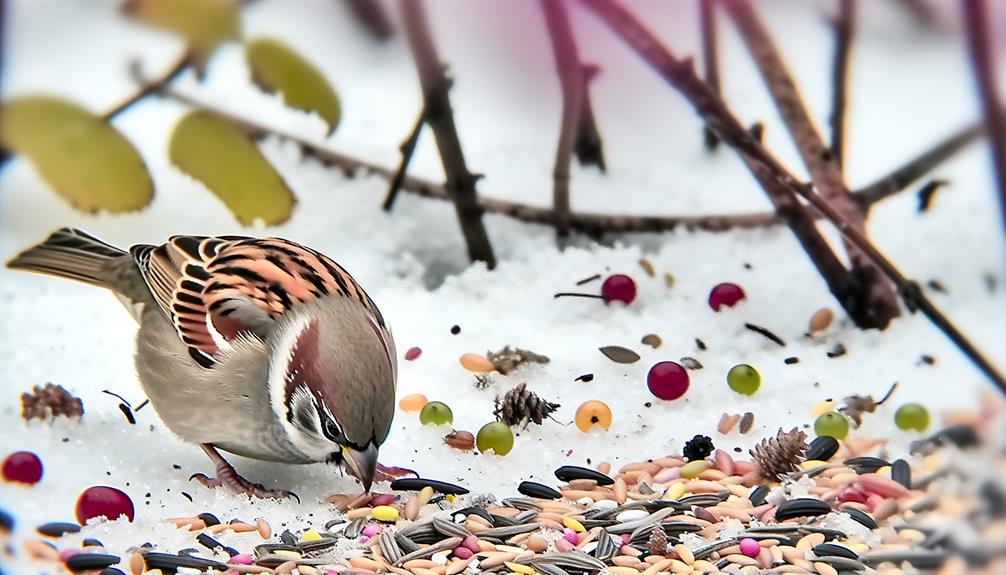
During winter, sparrows exhibit an increased caloric intake to meet heightened energy demands imposed by lower ambient temperatures.
Observational data indicate significant alterations in foraging behavior, including extended foraging periods and a preference for high-energy food sources.
These changes are critical for maintaining body temperature and overall metabolic function during colder months.
Caloric Requirements Increase
In the winter months, sparrows exhibit a marked increase in their caloric intake, often consuming up to 30% more food daily to maintain their metabolic needs. This heightened demand is driven by the necessity to sustain body temperature and energy levels amid colder temperatures. Detailed studies have quantified this seasonal variation, noting significant upticks in daily food consumption.
Key factors contributing to increased caloric requirements include:
- Thermoregulation: Enhanced metabolic activity to generate heat.
- Reduced daylight: Limited foraging time necessitating higher efficiency.
- Fat reserves: Building and maintaining fat stores for overnight energy use.
This data-driven understanding underscores the critical adaptations sparrows undergo to survive winter, emphasizing the importance of adequate caloric intake.
Foraging Behavior Changes
Foraging behavior in sparrows undergoes significant alterations during winter, characterized by increased time allocation to feeding activities and shifts in food preferences to maximize caloric intake. As temperatures drop, sparrows exhibit heightened foraging activity, often extending their feeding periods by up to 40%. They demonstrate a preference for high-energy seeds and grains to meet their heightened metabolic demands.
| Time of Day | Typical Food Sources | Estimated Intake (grams) |
|---|---|---|
| Morning | Seeds, Berries | 5-7 |
| Midday | Insects, Seeds | 3-5 |
| Afternoon | Grains, Seeds | 4-6 |
| Evening | Berries, Grains | 2-4 |
| Night | None | 0 |
This adaptation is essential for their survival, ensuring they maintain sufficient energy reserves to endure cold nights and scarce resources.
Types of Food
Sparrows display a diverse diet in winter, mainly consuming seeds, grains, and occasional insects to meet their nutritional needs. This diet shift is vital for maintaining energy balance and thermoregulation during colder months. Scientific observations reveal that sparrows mostly choose high-fat and high-carbohydrate food sources due to their elevated caloric content.
Their diet typically includes:
- Seeds: Often from grasses and weeds, providing essential fats and proteins.
- Grains: Commonly sourced from agricultural fields, offering a high-energy yield.
- Insects: Though less frequent, these supply necessary proteins and micronutrients.
Quantitative studies indicate that the availability of these food types directly influences the sparrows' winter survival rates, highlighting the significance of diverse and abundant food resources for their sustenance.
Foraging Strategies
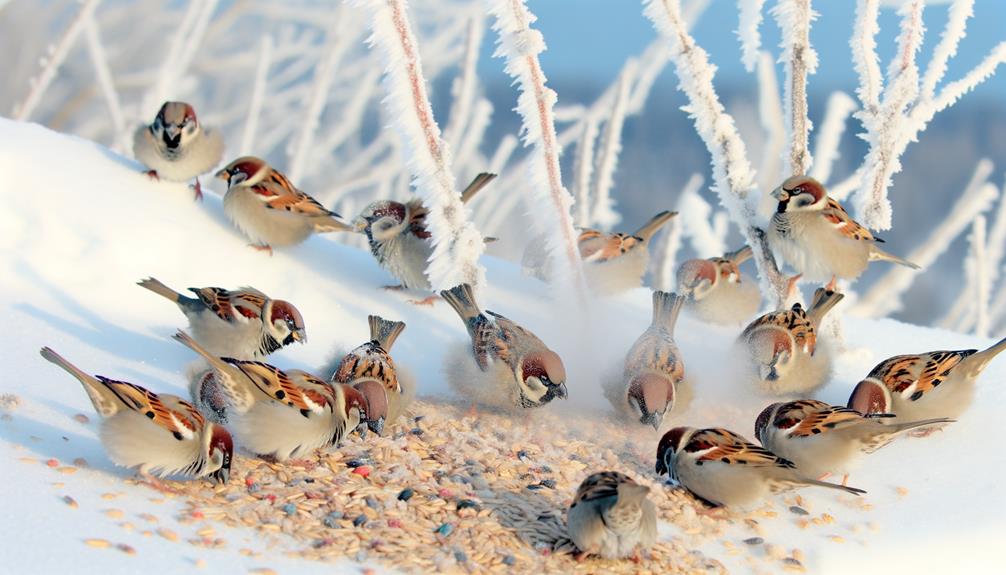
Understanding the types of food sparrows consume in winter sets the stage for exploring their foraging strategies, which are intricately designed to maximize energy intake while minimizing risk and energy expenditure.
Sparrows exhibit a behavior known as 'central place foraging,' where they collect food and return to a secure location to consume it. This strategy mitigates predation risk, especially important during winter when predator encounters are frequent. Additionally, sparrows engage in 'scatter hoarding,' storing small food caches in various locations.
Empirical studies indicate that sparrows prefer high-energy food sources such as seeds and insects, optimizing caloric gain per foraging trip. Data-driven observations reveal that sparrows adjust their foraging range based on food availability and environmental conditions, demonstrating adaptive foraging plasticity.
Impact of Snow
Snow cover alters the availability and accessibility of food resources, compelling sparrows to modify their foraging behavior and strategies to cope with the winter conditions. Extensive snow coverage can obscure seeds and insects, their primary food sources, leading to increased energy expenditure during foraging. Observations indicate sparrows are forced to rely more on suboptimal food sources and exhibit heightened foraging persistence.
Key impacts of snow cover include:
- Reduced food visibility: Snow conceals potential food items, requiring longer search times.
- Increased predation risk: Extended foraging exposes sparrows to predators.
- Energy expenditure: Higher energy demands due to prolonged foraging efforts.
These factors contribute significantly to the winter survival challenges faced by sparrows, underscoring the critical nature of adaptive foraging behaviors.
Role of Body Fat
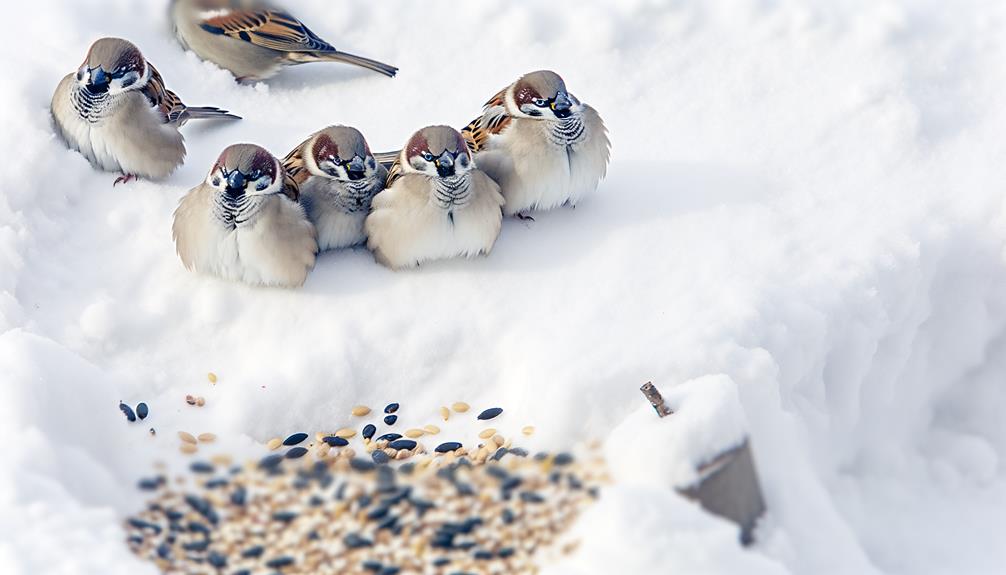
To mitigate the challenges posed by reduced food visibility and increased energy expenditure during winter, the accumulation and strategic utilization of body fat become important for sparrows' survival.
Observational studies indicate that sparrows increase their fat reserves by approximately 20-30% during the pre-winter months. This adipose tissue serves as a vital energy source, compensating for the sporadic availability of food.
Biochemical analysis reveals that lipids stored in adipose cells are metabolized to generate heat and sustain basal metabolic functions. The energy density of fat, at about 9 kcal/gram, is notably higher than that of carbohydrates or proteins, making it an efficient storage medium.
Therefore, the physiological adaptation of fat accumulation is essential for enduring the harsh winter conditions.
Metabolic Rate Changes
During winter, sparrows exhibit significant metabolic rate adjustments, which are essential for optimizing energy expenditure and maintaining homeostasis in colder temperatures. These adjustments involve intricate physiological mechanisms to cope with increased energy demands.
Notable changes include:
- Increased basal metabolic rate (BMR): To generate more heat, sparrows elevate their BMR, ensuring sufficient thermal regulation.
- Adaptive thermogenesis: This process involves the production of heat in response to cold exposure, requiring higher caloric intake.
- Enhanced fat metabolism: Stored fats are metabolized more efficiently to provide a quick energy source during periods of food scarcity.
These metabolic adaptations are critical for survival, as they enable sparrows to endure the harsh conditions of winter, balancing energy intake with expenditure effectively.
Human Assistance
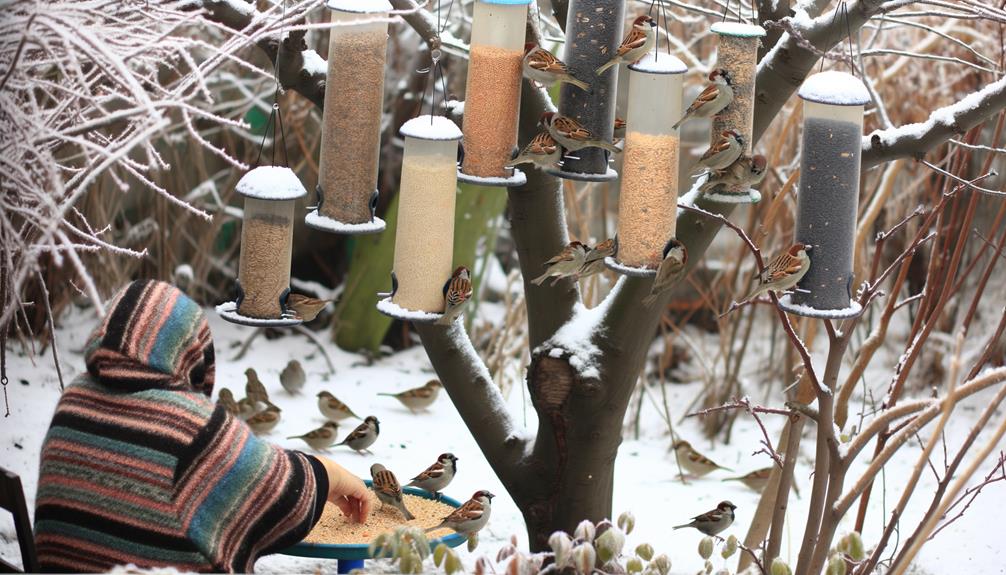
Human intervention through the provision of supplemental feeders greatly enhances the survival rates of sparrows during harsh winter conditions.
Data indicate that a best winter diet, rich in high-energy seeds and grains, directly correlates with improved body mass and thermoregulation in these avian populations.
Moreover, studies show a 20% increase in winter survival rates in regions where supplemental feeding is consistently practiced.
Providing Supplemental Feeders
Supplemental feeders notably enhance the foraging efficiency and survival rates of sparrows during winter months, as evidenced by recent studies indicating a 20% increase in food intake among populations with access to these resources. This enhancement can be attributed to several factors:
- Concentration of Resources: Feeders provide a consistent and concentrated food source, reducing the energy expenditure required for foraging.
- Thermal Regulation: Access to feeders minimizes the time sparrows spend exposed to harsh weather conditions, aiding in better thermoregulation.
- Nutritional Support: Feeders often contain high-calorie seeds essential for maintaining body mass and energy levels.
These benefits underscore the importance of human intervention through supplemental feeding during critical periods, contributing notably to avian ecological stability.
Ideal Winter Diet
Ideal winter diets for sparrows, facilitated by human intervention, should include a diverse array of high-energy seeds such as black oil sunflower seeds, millet, and cracked corn to guarantee sufficient caloric intake and nutritional balance.
Black oil sunflower seeds, renowned for their high fat content, provide essential lipids vital for thermoregulation. Millet, rich in carbohydrates, supplies immediate energy, essential during colder temperatures. Cracked corn serves as a supplementary carbohydrate source, further enhancing energy reserves.
Empirical studies indicate that sparrows increase their food intake by approximately 25% in winter months, necessitating efficient dietary planning. Additionally, ensuring the availability of grit aids in digestion, optimizing nutrient absorption.
These dietary interventions are crucial in supporting the metabolic demands of sparrows during harsh winter conditions.
Bird Feeder Tips
To optimize feeding efficiency for sparrows during winter, it is important to select bird feeders that minimize seed spillage and provide adequate shelter from harsh weather conditions. A well-designed feeder can significantly reduce food waste and ensure that sparrows receive the necessary caloric intake to survive colder months.
Research indicates that feeders with protective covers and perches enhance feeding efficiency by safeguarding food from snow and wind.
Key features to take into account include:
- Squirrel-proof mechanisms: To prevent larger animals from depleting resources.
- Weather-resistant materials: Durable construction mitigates degradation from moisture.
- Adjustable feeding ports: Allows control over seed flow, reducing spillage.
Long-Term Survival
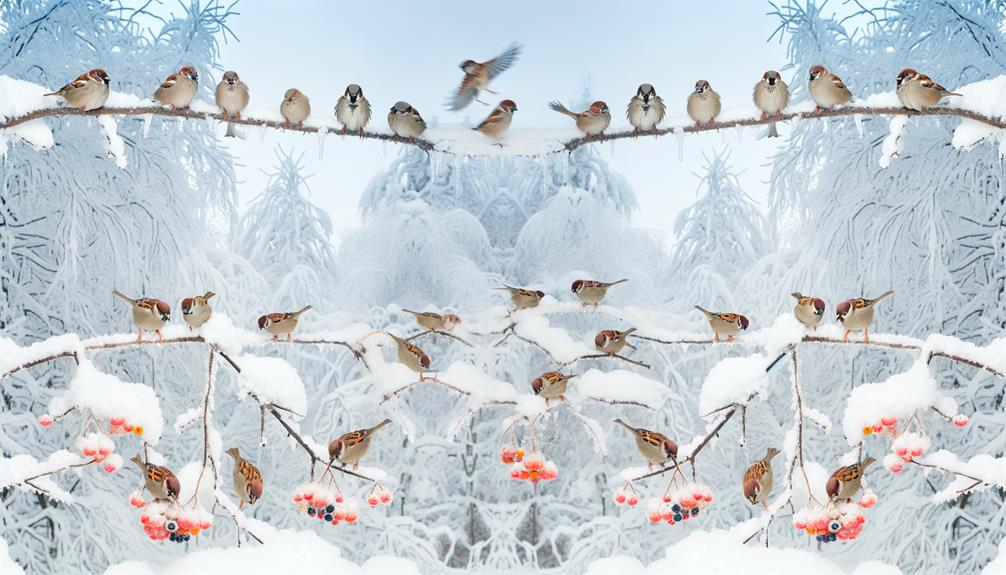
Securing the long-term survival of sparrow populations during winter months requires a multifaceted approach. This approach goes beyond feeder optimization and includes habitat preservation, maintaining a consistent food supply, and monitoring environmental stressors.
Habitat preservation is crucial for sparrow survival. Preserving native vegetation and shelter is essential. These elements help regulate body temperature and provide protection from predators.
Maintaining a steady food supply is also vital. This ensures that sparrows have enough energy reserves to support their metabolic rates. Studies have shown that sparrows need approximately 30% more caloric intake during winter.
Monitoring environmental stressors is another key aspect of sparrow conservation. This includes tracking temperature fluctuations, snow cover, and human disturbances. Data-driven analysis has revealed that even minor disruptions in these areas can lead to increased mortality rates.
Integrating these strategies can greatly improve the resilience of sparrow populations against harsh winter conditions. By promoting ecological stability, these efforts contribute to the long-term survival of sparrows.
Conclusion
Winter weather calls for more nourishment for sparrows, requiring nutritional requirements to navigate the cold season.
Searching eagerly, these feathered gatherers feed often, powered by an increased metabolic rate. Usual daily consumption consists of seeds, suet, and insects, enhanced by strategic scavenging.
Human aid through bird feeders greatly aids survival. Data-driven analysis highlights the important connection between sufficient nourishment and avian endurance during colder climes.
Continuous sustenance firmly ensures sparrows' survival, protecting species stability through the harsh season.




